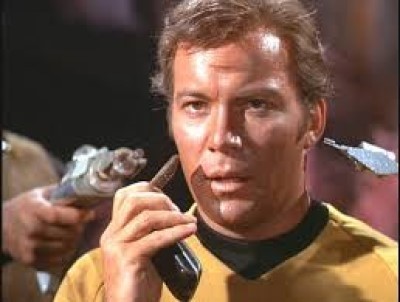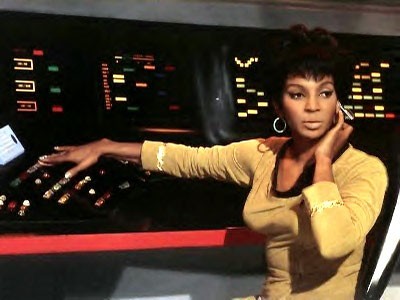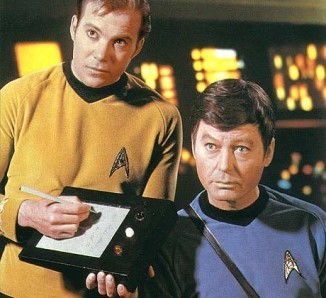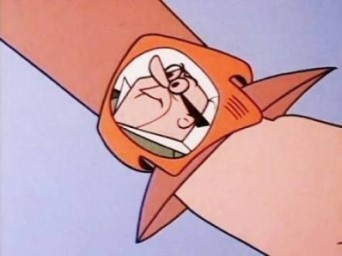What has Science Fiction done for us? December 9, 2020 – Posted in: Book News, Top 10s
Have you ever wondered how the inventors of some of our everyday gadgets and the technology we rely on came up with the idea in the first place? Well, would you be surprised to know that it may have been through reading science fiction books!
“Anything one man can imagine; other men can make real.” — Jules Verne
Here is my top 10 of ‘stuff’, in no particular order, that were in science fiction books before they became common place.
1. Mobile Phone and Bluetooth Earbuds
- Star Trek Communicator
- Star Trek Wireless Receiver
The iconic Communicator device on Star Trek, first shown in 1966, looked a lot like a flip phone. Though engineers were working on developing this technology in the 1960s, it took Motorola until 1983 to develop and produce what could be called a mobile phone but these were large, heavy, and expensive. The company’s first flip phone, released in 1989, was similar to the Star Trek device.
In the 1953 novel Fahrenheit 451, author Ray Bradbury wrote about “seashells” and “thimble radios” that resemble earbuds and headsets with bluetooth capability. This may also have inspired the writers of Star Trek where Uhura, the communications office, wore an earpiece that was a wireless receiver that allowed her to receive and make calls, via the computer, to anyone with a communicator. This is very much like Bluetooth ear buds that allow you to use your mobile phones hands free
2. The Tablet (iPad and Galaxy Note)
- Star Trek PADD
- 2001 A Space Odyssey
 Believe it or not the first patent for a system that recognised handwritten characters by analysing the handwriting motion was granted in 1914 but it wasn’t until 1992 that Apple produced the Newton which was one of the first Personal Digital Assistants which looked very much like those first seen in Star Trek. These devices were known as Personal Access Display Devices as the series developed these also became more like the tablets we know today.
Believe it or not the first patent for a system that recognised handwritten characters by analysing the handwriting motion was granted in 1914 but it wasn’t until 1992 that Apple produced the Newton which was one of the first Personal Digital Assistants which looked very much like those first seen in Star Trek. These devices were known as Personal Access Display Devices as the series developed these also became more like the tablets we know today.
The first touchscreen device, as we now know it, was when Arthur C. Clarke wrote about an electronic paper or the “newspad” that people in this world read and was imagined by Stanley Kubrick in 2001 A Space Odyssey where there is a flatscreen tablet device wirelessly playing a video broadcast. Tablets that were close to that seen in the movie weren’t available until the Apple iPad released in 2010.
3. Video Calls (Skype and Facetime)
 The concept of video calls was first conceived in the late 1870s and mentioned as a Telephote in a Jules Verne’s 1889 short story Year 2889. although the basic sciences to permit its very earliest trials would take nearly a half century to be discovered
The concept of video calls was first conceived in the late 1870s and mentioned as a Telephote in a Jules Verne’s 1889 short story Year 2889. although the basic sciences to permit its very earliest trials would take nearly a half century to be discovered
While not a true video call, an early reference to making a call with an image is in Victor Appleton’s 1914 novel, Tom Swift and His Photo Telephone. This phone allowed the recipient to see who the caller was but not a moving picture. A side-improvement to the whole system is done when Tom attaches a phonograph cylinder recorder to the telephone system, preserving not only a visual image but an audio recording.
Thea Von Harbou’s 1925 novel Metropolis features a wall-mounted videophone which was visualised in Fritz Lang’s 1927 film of the book. With each decade, videophones shown in films were becoming more sophisticated as technology improved. Video calling is also mentioned in Arthur C. Clark’s 2001 A Space Odyssey where a public booth contains a large phone unit. We wonder if he was inspired by the film Metropolis 😊
- 1927 Film Metropolis
- 1968 2001 A Space Odyssey
4. Robots and Androids
 Robots and androids have been, and continue to be, a staple of science fiction since legends of talking bronze and clay statues coming to life were mentioned in works by Homer, Plato and Pliny (heavy duty reading, but these are not what we are talking about)
Robots and androids have been, and continue to be, a staple of science fiction since legends of talking bronze and clay statues coming to life were mentioned in works by Homer, Plato and Pliny (heavy duty reading, but these are not what we are talking about)
Between 1940 and 1950, Isaac Asimov wrote many short stories and which contained robots and he developed the Three Laws of Robotics which he brought together in his book I Robot, first published in 1950. Asimov’s three laws continue to shape the understanding and design of artificial intelligence to this day.
Some robots and androids have become enshrined in science fiction folklore from Robby the robot and WALL-E to C3-PO, R2-D2 and BB-B from Star Wars. And let’s not forget Data from Star Trek.
We still have a ways to go before we have androids but robot development is well underway with a number of robots available that can help with day-to-day operations of your home (get one for mum and dad 😊).
Useless fact: The word robot was first mentioned in a 1921 science fiction play by the Czech writer Karel Capek called R.U.R. which stands for Rossum’s Universal Robots. The Robots described in Capek’s play are not robots as we think of them, but rather artificial biological organisms that may be mistaken for humans so more like androids.
5. Virtual Assistants (Alexa/Siri)
 In addition to tablets, Arthur C. Clark also envisioned the voice-activated super computer HAL 9000, which, while a lot bigger, is not unlike voice-activated virtual assistants such as Alexa, Siri and Google Assistant that can answer questions and are now a regular feature of many homes and businesses. He also warned of the dangers represented by artificial intelligence, a theme that still reoccurs regularly in science fiction.
In addition to tablets, Arthur C. Clark also envisioned the voice-activated super computer HAL 9000, which, while a lot bigger, is not unlike voice-activated virtual assistants such as Alexa, Siri and Google Assistant that can answer questions and are now a regular feature of many homes and businesses. He also warned of the dangers represented by artificial intelligence, a theme that still reoccurs regularly in science fiction.
The Hitchhikers Guide to the Galaxy by Douglas Adams was published in 1979 and has it all. The Hitch Hikers Guide itself is described as “a portable, handheld electronic device which is the standard repository for all knowledge and wisdom”. Adams does pretty much predict the tablets, e-books, Wikipedia, and devices like Siri and Alexia. He also writes about a little fish called “the Bable fish” which lives in your ear and translates all inter-galactic language for you. Sounds quite a lot like a translation app or even the universal translator described in Star Trek.
6. Virtual Reality
 In 1935 American science fiction writer Stanley G. Weinbaum presented a comprehensive and specific fictional model for virtual reality in his short story Pygmalion’s Spectacles. In the story, the main character, Dan Burke, met an elfin professor, Albert Ludwig, who invented a pair of goggles which enabled………“a movie that gives one sight and sound […] taste, smell, and touch. […] You are in the story, you speak to the shadows (characters) and they reply, and instead of being on a screen, the story is all about you, and you are in it.”
In 1935 American science fiction writer Stanley G. Weinbaum presented a comprehensive and specific fictional model for virtual reality in his short story Pygmalion’s Spectacles. In the story, the main character, Dan Burke, met an elfin professor, Albert Ludwig, who invented a pair of goggles which enabled………“a movie that gives one sight and sound […] taste, smell, and touch. […] You are in the story, you speak to the shadows (characters) and they reply, and instead of being on a screen, the story is all about you, and you are in it.”
You can now get Virtual Reality headsets that allow the wearer to enter a virtual world and with video games allowing the wearer to enter a virtual reality, science fiction has now become science fact. The 2011 novel Ready Player One by Ernest Cline, which is about a virtual reality system called the OASIS that people use to escape from the grim reality of a dying Earth in 2045 is a great modern take on Pygmalion’s Spectacles.
7. Smart Watches
Dick Tracy comics debuted in the 1930s, but it wasn’t until 1946 that they evolved to include the intrepid detective’s iconic Two-Way Wrist Radio. Dick Tracy would use it to communicate with fellow police, a distinct crime-fighting advantage — and something that seemed cutting-edge to readers at the time. The device became a Two-Way Wrist TV in 1964 which is two years after The Jetsons cartoon show predicted the likes of Skype or FaceTime to make video calls. The characters were sometimes shown wearing large watches that could be used for video calls, or for just watching TV but this is maybe a few years away.
8. World Wide Web (a.k.a. The Internet)
 The earliest reference to something that could be likened to the Internet is in a fictional criminal short story from 1898 called “From The Times of 1904” by Mark Twain who dreamed up a device called the telectrophonoscope which used the existing phone system to create a world wide network of information-sharing. In Twain’s short story, as early as in 1904, telectrophonoscopes are spread all over the globe, and every man can get one and exchange visual and sound information with all other owners of telectrophonoscopes.
The earliest reference to something that could be likened to the Internet is in a fictional criminal short story from 1898 called “From The Times of 1904” by Mark Twain who dreamed up a device called the telectrophonoscope which used the existing phone system to create a world wide network of information-sharing. In Twain’s short story, as early as in 1904, telectrophonoscopes are spread all over the globe, and every man can get one and exchange visual and sound information with all other owners of telectrophonoscopes.
In the 1946 novel, A Logic Named Joe by Murray Leinster everyone has a device in their homes called a “Logic”. This Logic is connected to a data “tank” which possess all knowledge. The Logic is used to provide people with information as they need it. (Sound familiar?) The story explores not only the possibility of the internet, but also the social ramifications of providing limitless information to an all too “human” and imperfect society.
Useless Fact: Tim Berners-Lee, the inventor of the World Wide Web, wasn’t actually inspired by a science fiction novel but rather a how-to-book first published in 1856 called Enquire Within upon Everything.
9. The TASER
 The TASER is a less-lethal force option for police to use to subdue escaping, aggressive, or potentially dangerous people, who would have otherwise been subjected to more lethal force options such as guns.
The TASER is a less-lethal force option for police to use to subdue escaping, aggressive, or potentially dangerous people, who would have otherwise been subjected to more lethal force options such as guns.
Jack Cover, a NASA researcher, began developing the first Taser in 1969 the name of this piece of policing equipment is an anacronym of Tomas A Swift’s Electric Rifle, one of Jack Cover’s favourite books from his childhood. It is also suggested that the book also gave him the idea in the first place. Although Tom’s electric rifle was a bit more lethal than the TASER!
10. Bionic Limbs
 Robert Louis Stevenson wrote Treasure Island in 1888 and as everyone knows Long John Silver had a wooden leg and Captain Hook in Peter Pan by J. M. Barrie had a hook for a hand. In 1818 Mary Shelley’s Frankenstein was created using other people’s bits and pieces but it wasn’t until around 1925 where the character Rotwang, in Metropolis, has a black mechanical right hand.
Robert Louis Stevenson wrote Treasure Island in 1888 and as everyone knows Long John Silver had a wooden leg and Captain Hook in Peter Pan by J. M. Barrie had a hook for a hand. In 1818 Mary Shelley’s Frankenstein was created using other people’s bits and pieces but it wasn’t until around 1925 where the character Rotwang, in Metropolis, has a black mechanical right hand.
But it’s not until Martin Caidin’s 1972 novel Cyborg which follows pilot Steve Austin (The Six Million Dollar Man), who gets seriously injured from crashing during a flight. He is left with only one limb and blind in one eye. In the novel, a group of scientists are able to provide Austin with new legs, a bionic arm and a removable eye with a camera, making him a mixture of human and machine or a ‘cyborg’. The novel was written over 20 years before the first bionic arm transplant.
Want to know more?
 From Science Fiction to Science Fact explores the visions of the writers, futurists and far-sighted inventors who made those realities, from the direct influence of H.G. Wells on the atomic bomb and the tank, to the ambitious prototypes created by inventors ahead of their time, such as Nikola Tesla’s remote-controlled drone ships.
From Science Fiction to Science Fact explores the visions of the writers, futurists and far-sighted inventors who made those realities, from the direct influence of H.G. Wells on the atomic bomb and the tank, to the ambitious prototypes created by inventors ahead of their time, such as Nikola Tesla’s remote-controlled drone ships.
The history and development of each technology is detailed and related in context, exploring the road from prescient fictional representation to real-life technology. Meet the greatest names and works in sci-fi, from Jules Verne and Aldous Huxley to Arthur C. Clarke and Isaac Asimov, Star Trek to the Bionic Man, alongside visionary inventors such as Tesla and Wernher von Braun.
“What the writers of modern science fiction invent today, you and I will do tomorrow” – J.G. Ballard.












